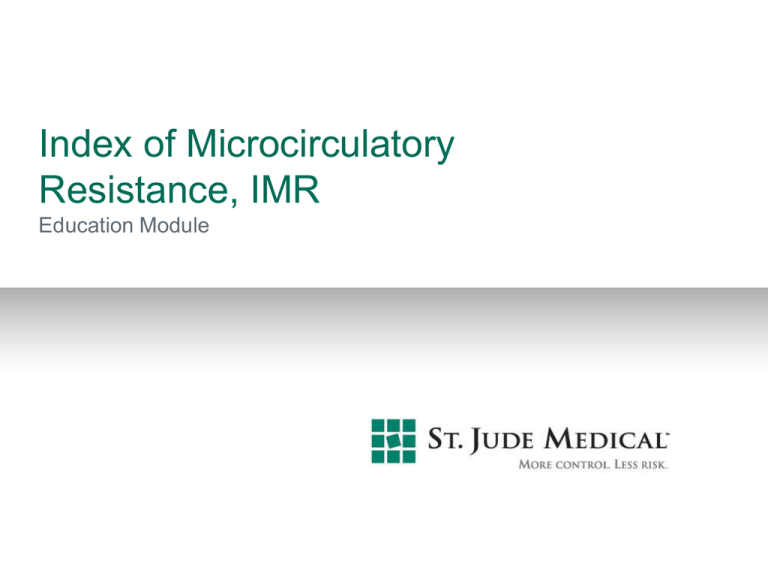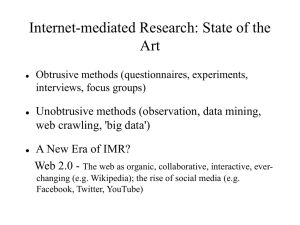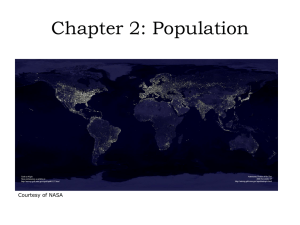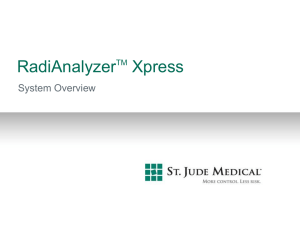
Index of Microcirculatory
Resistance, IMR
Education Module
Module Content
Coronary Resistance
Index of Microcirculatory Resistance (IMR)
Calculation of IMR
IMR Measurement Procedure
1. Preparation
2. Positioning Sensor
3. Calibrate PressureWire and Enter CFR Mode
4. Test Injection
5. Hyperemic Injections
6. Review Result and Calculate IMR
Validation of IMR
Clinical applications of IMR
Summary
2
Coronary Resistance
Blood flow resistance in a normal coronary vascular tree
Arterioles
Capillaries
Epicardial
Vessel
Kaul and Jayaweera Eur Heart J 2006;27:2272-74.
3
Venules
Index of Microcirculatory Resistance (IMR)
Invasive and quantitative method
for evaluating the microcirculation
IMR
FFR: Specific for epicardial disease
CFR: Affected by both epicardial and
microcirculatory disease (cannot
distinguish between the two)
IMR: Specific for microcirculatory
disease
FFR
CFR
4
Index of Microcirculatory Resistance (IMR)
Potential Advantages
Readily available in the cath lab
(PressureWire™ Certus + RadiAnalyzer™ + RadiView™)
Specific for the microvasculature
Quantitative and reproducible
Predictive of outcome
5
Calculation of IMR
Myocardial resistance = pressure drop across the myocardium divided by flow
Myocardial resistance = ∆ pressure / flow
Pd
Flow
Pv (~ 0)
Myocardial resistance
∆ Pressure = Pd - Pv = Pd (assuming Pv = 0)
Flow 1 / Tmn
IMR = Pd / (1 / Tmn)
IMR = Pd x Tmn (at maximal hyperemia)
6
Calculation of IMR
IMR =
=
=
Pd x Hyperemic Tmn
89 x 0.37
33
(108)
Pa mean
(89)
Pd mean
0.82
FFR
2.4
CFR
33
IMR
Normal IMR < 20
7
IMR Measurement Procedure
1. Preparation
Use a 6 F guiding catheter
Arrange the manifold with a 3-way stop-cock (pressure, saline and contrast)
Use a syringe with a safety reservoir
8
IMR Measurement Procedure
2. Positioning Sensor
1. Place the sensor distally in the artery (>5 cm from the catheter opening).
If the distance between sensor and catheter is too short, Tmn variability will
increase and accuracy will be reduced.
2. The sensor should remain in the same position during each injection.
The calculation will be affected if the sensor element is moved.
9
IMR Measurement Procedure
3. Calibrate PressureWire and Enter CFR Mode
10
IMR Measurement Procedure
4. Test Injection
1. Fill the syringe with 3 ml of
saline.
2. Vigorously inject the saline
into the guiding catheter
and check that there is a
decline in sensor
temperature of at least 2
degrees.
11
IMR Measurement Procedure
5. Hyperemic Injections
1. Move green marker to
“Hyp” using the arrow keys
2. Induce steady state
hyperemia. Flush to remove
any warm fluids from the
catheter.
3. Press REC
4. Vigorously inject saline 3
times according to screen
instructions
12
IMR Measurement Procedure
6. Review Result and Calculate IMR
1. Press STOP to end
measurement
procedure and review
result in stop/view
mode
2. Transfer the recording
to RadiView and
review IMR
3. Alternatively IMR can
be calculated
manually on Xpress
as Pd x Tmn Hyp
(108)
Pa mean
(89)
Pd mean
0.82
FFR
2.4
CFR
33
IMR
13
Limitations of IMR
Invasive
Interpatient variability:
Sensor-catheter distance
Amount of myocardium supplied by the measured vessel
Full independence of epicardial stenosis requires
measurement of coronary wedge pressure
14
Validation of IMR
Animal Model
Guide
LAD
Radio-opaque
Occluder
Pressure
Wire
Flow Probe
Circulation 2004;109:2269-2272.
15
IMR Is Independent of Epicardial Stenosis?
Animal Validation
Circulation 2004;109:2269-2272.
16
Validation of IMR
Change in IMR After Disruption of the Microcirculation
p = 0.002
30
25
IMR
20
15
10
5
0
Normal
Microcirculation
Circulation 2003;107:3129-3132
17
Abnormal
Microcirculation
Reproducibility of IMR
CFR had a significantly greater variation than IMR
after changes in blood pressure, heart rate and contractility
Correlation with Baseline
1.0
P<0.05
0.8
0.6
0.4
0.2
0.0
IMR
Ng et al. Circulation 2006;113:2054-61.
18
CFR
FFR
Role of IMR
STEMI Case 1
IMR after PCI
IMR = Pd x Tmn = 32 x 1.55 = 50
(45)
Pa mean
(32)
Pd mean
0.71
FFR
0.9
CFR
50
IMR
IMR = 50
Peak CK=3754
Initial EF=37%
F/U EF=37%
20
STEMI Case 2
IMR after PCI
IMR = Pd x Tmn = 57 x 0.47 = 27
(75)
Pa mean
(57)
Pd mean
0.77
FFR
2.0
CFR
IMR = 27
27
IMR
Peak CK=1008
Initial EF=42%
F/U EF=62%
21
Predictive Value of IMR after PCI for STEMI
J Am Coll Cardiol 2008;51:560-5
Echo Wall Motion and IMR
Follow-Up Echo Wall Motion Score and IMR
J Am Coll Cardiol 2008;51:560-5
Predictive Value of IMR after PCI for STEMI
Correlation between measures of microvascular function and peak CK
and 3 month echocardiographic wall motion score.
J Am Coll Cardiol 2008;51:560-5
Predictive Value of IMR after PCI for STEMI
J Am Coll Cardiol 2008;51:560-5
STEMI and Effect of Therapy
Applications of IMR: STEMI
41 patients randomized to IC SK or placebo after primary PCI for STEMI.
IMR was significantly lower (16 vs. 32, p<0.001) in the SK group.
N Engl J Med 2007;356:1823-34
Stable CAD
IMR after PCI in Stable CAD
•
50 patients randomized to
conventional stenting with
predilatation versus direct
stenting
•
IMR measured after PCI and
correlated with troponin
release.
•
In the 10 patients with elevated
Tn post PCI, IMR was 24.7 +
13.3 vs. 16.9 + 10.2, p=0.04
Cuisset, et al. JACC; 2008:51:1060
IMR and the Effect of Therapy
IMR post Stem Cell Therapy
IMR measured in 15 patients with ischemic cardiomyopathy
before and 6 months after intracoronary stem cell delivery.
Tayyarcci, et al. Angiology 2008;59:145
IMR Post Transplant
Applications of IMR: Post Transplant
PIA II Study
J Heart Lung Transplant 2006;25:765-71
IMR Post Transplant
Applications of IMR: Post Transplant
PIA II Study
J Heart Lung Transplant 2006;25:765-71
IMR Post Transplant
Applications of IMR: Post Transplant
PIA II Study
J Heart Lung Transplant 2006;25:765-71
IMR Post Transplant
Lack of Relationship between Epicardial
Atherosclerosis and Microvascular Dysfunction
IMR in 101 patients with atherosclerosis and 15 without
Melikian et al. Cathet Cardiovasc Intervent 2009: submitted
IMR in Daily Practice
If FFR is normal, but patient has risk factors, chest pain
and evidence of ischemia.
Use IMR to find out why the patient had abnormal noninvasive tests – is it related to microvascular disease?
Role of IMR
Assessing microvascular damage in ACS or peri-PCI
For risk stratification in patients with STEMI: after treatment of
the epicardial vessel, use IMR to identify high risk patients who
will continue to have persistent LV dysfunction as opposed to
lower risk who will recover their LV function with time.
May have application for adjunctive treatment such as stem cell
therapy, given only to the high risk group.
In conjunction with FFR, to distinguish between epicardial and
microvascular disease in stable, chest pain patients.
For assessment of microvascular dysfunction in patients with
chest pain, but normal epicardial vessels.
Serial evaluations as part of research protocols.
Rx Only
Please review the Instructions for Use prior to using these devices for a
complete listing of indications, contraindications, warnings, precautions,
potential adverse events and directions for use.
The product referenced is approved for CE Mark.
PressureWire is designed, developed and manufactured by St. Jude Medical
Systems AB. RadiAnalyzer Xpress RADI, ST. JUDE MEDICAL, the ninesquares symbol and MORE CONTROL. LESS RISK. are registered and
unregistered trademarks and service marks of St. Jude Medical, Inc. and its
related companies. ©2011 St. Jude Medical, Inc. All rights reserved.









